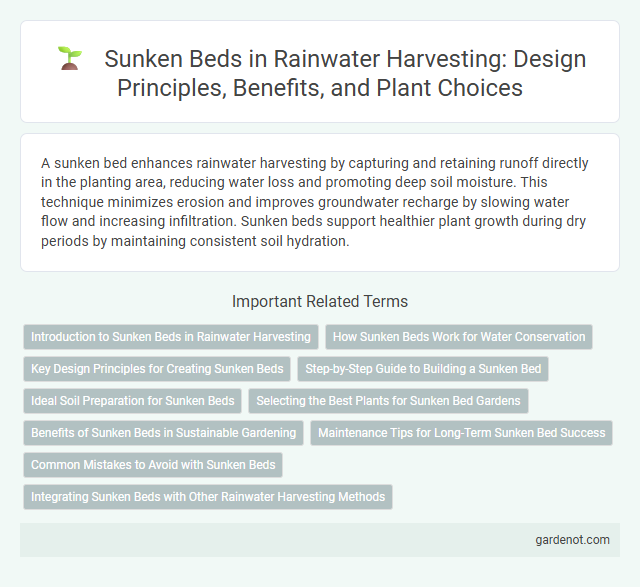A sunken bed enhances rainwater harvesting by capturing and retaining runoff directly in the planting area, reducing water loss and promoting deep soil moisture. This technique minimizes erosion and improves groundwater recharge by slowing water flow and increasing infiltration. Sunken beds support healthier plant growth during dry periods by maintaining consistent soil hydration.
Introduction to Sunken Beds in Rainwater Harvesting
Sunken beds in rainwater harvesting maximize water retention by creating depressions in the soil that capture and hold runoff, enhancing groundwater recharge and reducing surface erosion. These beds increase soil moisture availability for plants, promoting healthier vegetation and improved crop yields in arid and semi-arid regions. Implementing sunken beds optimizes natural rainwater infiltration, supporting sustainable agricultural practices and efficient water management.
How Sunken Beds Work for Water Conservation
Sunken beds improve water conservation by capturing and directing rainwater directly to plant roots, reducing surface runoff and evaporation. Their recessed design slows down water flow, allowing more infiltration into the soil, which enhances moisture retention and supports plant growth during dry periods. This method efficiently maximizes the use of available rainwater, making it ideal for sustainable gardening and agricultural practices in arid regions.
Key Design Principles for Creating Sunken Beds
Sunken beds are designed by excavating a shallow depression to increase water retention and soil moisture for plants, optimizing rainwater harvesting efficiency. Key design principles include ensuring proper slope gradient (typically 1-3%) to direct runoff into the bed, selecting well-draining soil to prevent waterlogging, and incorporating mulch layers to minimize evaporation. Strategic placement relative to the landscape contour lines maximizes water capture, while maintaining sufficient depth (15-30 cm) supports root development and sustainable plant growth.
Step-by-Step Guide to Building a Sunken Bed
Begin by selecting a low-lying area with adequate sunlight and digging a shallow trench approximately 12 to 18 inches deep to create the sunken bed. Compact the soil at the base and line the trench with organic matter like compost to improve water retention and fertility. Plant drought-tolerant crops suited for rainwater harvesting, then mulch the surface to reduce evaporation and promote moisture absorption.
Ideal Soil Preparation for Sunken Beds
Ideal soil preparation for sunken beds in rainwater harvesting involves loosening the soil to improve water infiltration and retention capacity. Incorporating organic matter such as compost or well-decomposed manure enhances soil structure, nutrient availability, and microbial activity. Ensuring the soil is free from compaction and adequately graded prevents waterlogging while maximizing the sunken bed's efficiency in capturing and storing rainwater.
Selecting the Best Plants for Sunken Bed Gardens
Selecting the best plants for sunken bed gardens involves choosing species that thrive in moisture-retentive soil and partial shade, such as ferns, hostas, and water-loving herbs like mint and lemon balm. Native plants adapted to local rainfall patterns enhance water retention and reduce maintenance needs. Incorporating deep-rooted perennials like daylilies improves soil structure and supports efficient rainwater absorption in sunken beds.
Benefits of Sunken Beds in Sustainable Gardening
Sunken beds enhance water retention by capturing and holding rainwater directly in the planting area, reducing irrigation needs and conserving water resources. This method improves soil moisture levels, promoting healthier root development and increasing plant resilience during dry periods. Sunken beds contribute to sustainable gardening by minimizing runoff, preventing soil erosion, and supporting efficient nutrient absorption.
Maintenance Tips for Long-Term Sunken Bed Success
Regularly remove debris and sediment from the sunken bed to prevent clogging and maintain effective water infiltration. Monitor soil moisture levels and amend organic matter to sustain soil health and promote plant growth. Inspect and repair any erosion or structural damage promptly to ensure long-term functionality of the rainwater harvesting system.
Common Mistakes to Avoid with Sunken Beds
Common mistakes in sunken bed rainwater harvesting include poor site selection that leads to waterlogging and inadequate soil permeability. Failing to contour sunken beds properly causes uneven water distribution, reducing infiltration efficiency. Neglecting regular maintenance such as debris removal can clog beds and diminish rainwater capture capacity.
Integrating Sunken Beds with Other Rainwater Harvesting Methods
Integrating sunken beds with contour trenches and check dams enhances rainwater retention and infiltration, maximizing soil moisture for crop growth. Combining these methods improves groundwater recharge by directing excess runoff into the sunken beds, reducing erosion and surface runoff. This synergy supports sustainable agriculture by maintaining soil health and increasing water availability during dry periods.
Sunken bed Infographic

 gardenot.com
gardenot.com